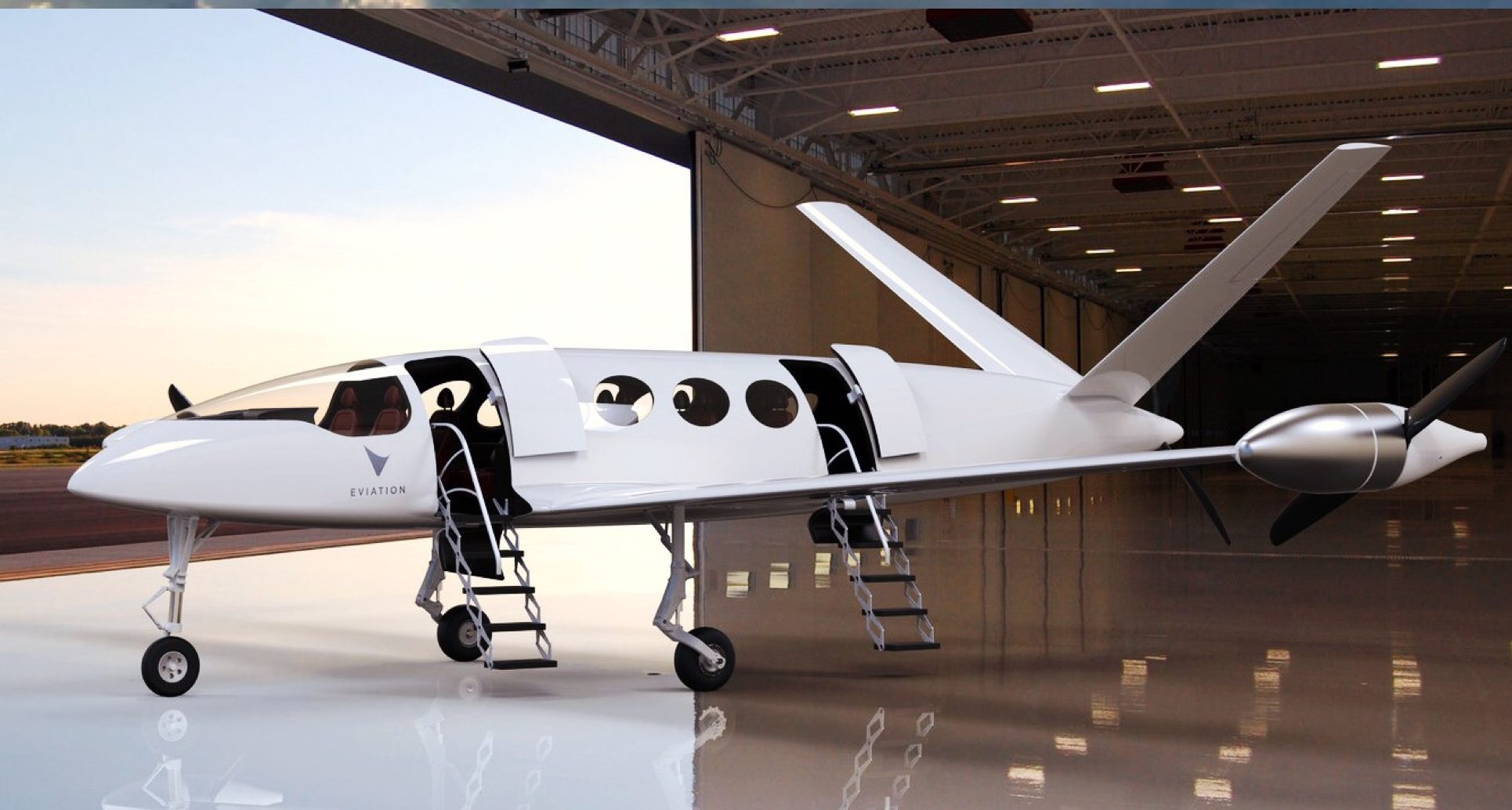

News
Tesla’s success ushers in a new era of electric flight
Electric flight may not be as far away as we once thought. In the next decade, aircraft are set to see dramatic changes as companies both large and small work to bring fully electric and hybrid flight to market. Airlines, manufacturers, and startups all seem to be moving towards this goal (see below). The race is clearly on and it will change the way we think about flight.
Yet as it was for the introduction of electric vehicles, the first aircraft is short range and seat just a few passengers. Their applications today are limited but to think the industry will stay in this nascent stage would be a mistake. Successes in these small and short-range aircraft will translate forward into larger and longer-range aircraft. The companies that find success here will emerge as leaders in a new era of electric flight.

Companies working on electric flight
On the Market Today:
First, it’s important to appreciate that only recently have small electric powered aircraft gone from concepts to commercial use.
Pipistrel’s Alpha Electro is one of these all-electric aircraft. It’s meant primarily for pilot training and just received its airworthiness certification from the FAA in April 2018, becoming the first in the USA to do so. The Alpha Electro only seats two people and is good for an hour of flight plus reserves. That might not sound like much but it could be disruptive. Pipistrel says the aircraft cuts beginner pilot training costs by as much as 70% while producing zero emissions and low noise.
In China, the Ruixiang RX1E is a similar style trainer sold there commercially. They also have a new, longer-range model that was recently tested, the RX1E-A. With a two-hour flight time the new version doubles its previous capabilities. At this size of aircraft the technology is getting close to parity with comparable gasoline-powered aircraft, like the Cessna 162 which has a flight time of about three hours.
Full parity might be here sooner than you think. Coming small electric aircraft have better specs and more seating, with many nearly ready for certification (pictured below). Pipistrel has their Panthera (top right), which will hold four passengers and will come in options for combustion, hybrid, and all-electric powertrains. There’s also BYE Aerospace in Colorado, which has a four-seater in development and just completed the first test flight of the two-seater Sun Flyer 2 — it has a flight time of 3 hours. Ruixiang also announced they have a 4-seater aircraft in development. The other important consideration is that their initial costs appear to be comparable to combustion options as well.
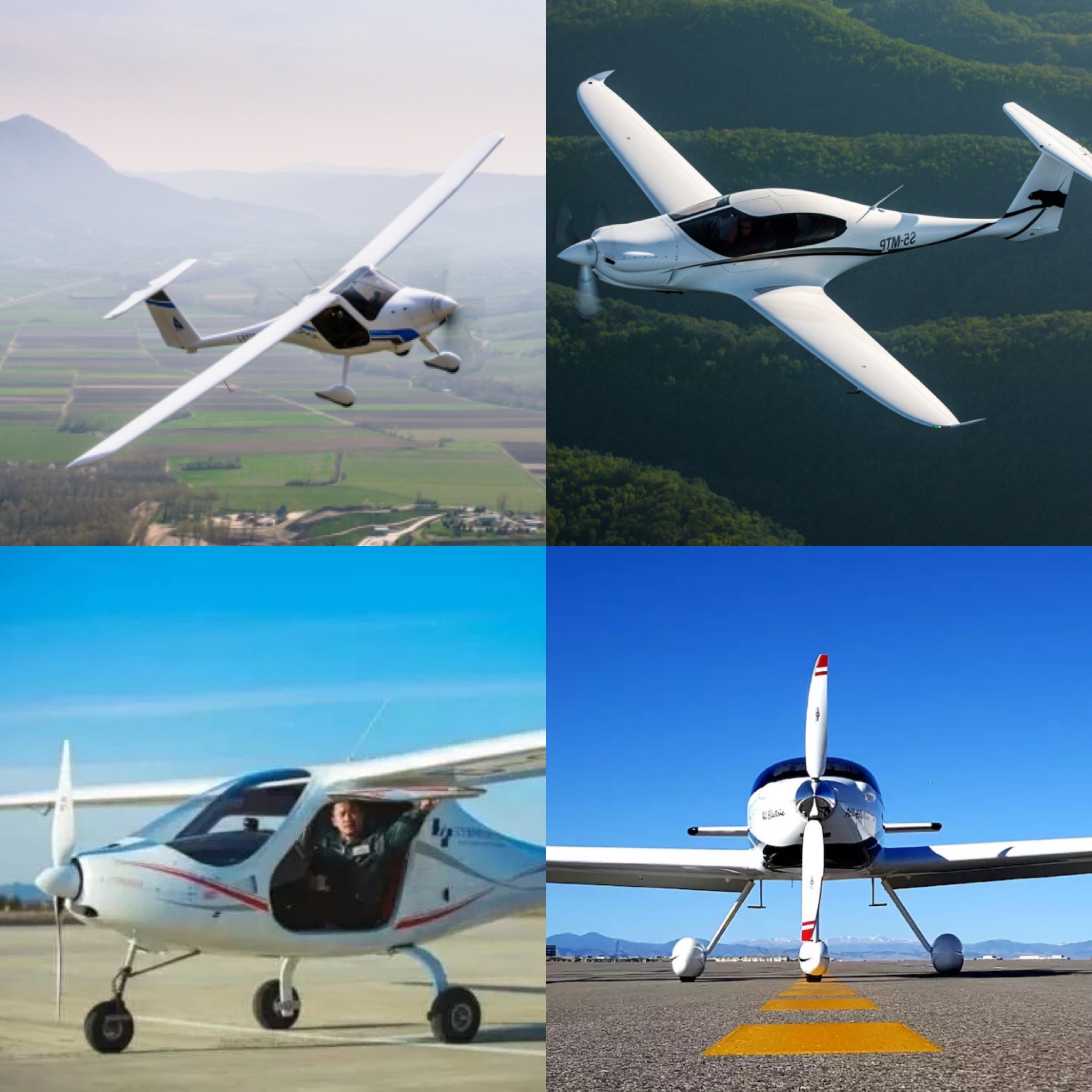
Pipistrel Alpha Electro (top left), Pipistrel Panthera (top right), Ruixiang RX1E-A (bottom left), BYE Aerospace Sunflyer 2 (bottom right)
Looking at these options, some will say that an electric aircraft is an isolated niche and for now, that’s mostly correct. These are small aircraft with limited applications. Yet when the Nissan Leaf and even the Tesla Roaster first came out many believed electric cars were a niche technology too. The range was too short, seating was too small, and costs were too high to realistically consider the technology going mainstream. Now we are in the midst of a market transformation, with automakers pouring billions into their EV programs and countries announcing they are phasing out combustion vehicles.
Market Transformation – Near-Term Preproduction:
The next major step for electric flight appears to be in small commuter aircraft. Aircraft that weigh less than 12,500 lbs, carry 5 to 20 passengers and travel up to 750 miles. In addition to regional commuter needs, they may also serve recreational and business purposes. If small aircraft are like the Tesla Roadster then these are like the Model S. They have more seats, longer range, and are made in higher volumes.
The use case of short range regional commuters is almost perfect for electrification. Much of their flight is spent just getting up to altitude, where cruising achieves the greatest efficiency. The time spent cruising however is relatively short and the result is that such regional flights are inherently less efficient than those over greater distances. On the plus side the high operating costs are a great opportunity for electrification. Consider that a turbine engine achieves an efficiency of around 55% at cruising, but on ascent that efficiency can drop by half (~25%). By comparison, an electric motor has efficiencies greater than 95%.
One of the companies working to electrify these regional aircraft is Wright Electric, based out of Los Angeles. They recently announced plans to bring to market a 9-seat electrified aircraft with a range of at least 340 miles. According to their website that would cover the distance of nearly 44% of all flights. The announcement is part of their new partnership with JetEx, a fixed-base operator based in Saudi Arabia with operations in over 30 countries. I recently spoke with Wright Electric’s CEO Jeff Engler about their coming aircraft and where he see’s the industry going. The first thing that surprised me is that their aircraft could be on the market very soon.
“We are certain that the first flight test will take place next year. It could be on the market in just over two years.” – Jeff Engler, CEO of Wright Electric
That means that sometime towards the end of 2020 or beginning of 2021 they could be in their air, operating with paying customers.
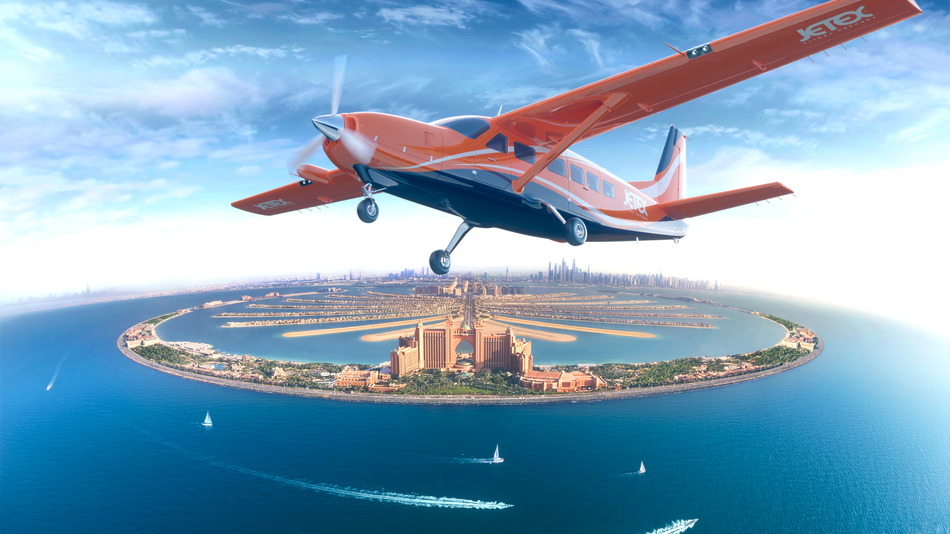
Wright Electric / JetEx
Their aircraft is intended for intercity travel and recreational activities Jeff said, but it’s not the end goal. In fact, their approach may be familiar to fans of electric cars.
“Our plan is similar to the Tesla approach, in the sense that they started with the Roadster and then scaled up to larger more mass market vehicles. Our first plane to market will be a premium aircraft meant to travel short distances with a small number of passengers… perfect for intercity flights and recreational activities like skydiving. This initial program is the springboard for development of larger longer-range aircraft”. – Jeff Engler, CEO of Wright Electric
In regards to the technology Jeff said they are developing the hybrid and all electric powertrains concurrently. He noted that battery advancements will dictate the transition to fully electric flight but in the interim, hybrid solutions will significantly reduce fuel costs, noise, and pollution. With restrained enthusiasm, he was cautiously optimistic about the coming advances in battery technology. Yet battery technology isn’t holding them up.
The beauty of hybrid options is that as batteries improve they can be seamlessly integrated into the design, allowing more of the flight to be electric. For their electric hybrid, Wright Electric likes to use the term “helper motor”. A helper motor can run hard during takeoff and ascent to help bring the aircraft up to altitude, thereby reducing the burden on the combustion engines, improving overall efficiency, and reducing fuel consumption. Once at altitude, the combustion engines can take over, where they operate most efficiently.
Even without being fully electric hybrid aircraft would have surprising benefits to fuel economy, pollution, and noise. Wright Electric has estimated the potential for reducing fuel use by nearly 2/3’s, while fellow electric aircraft startup Zunum Aero indicated 40% to 80% operating savings. Zunum Aero also noted a potential 70% reduction in community noise.
More Regional Commuter Aircraft are Coming Too:
Wright electric isn’t the only one working in this space. Other startups are also pushing the industry forward and they’ve partnered with established manufacturers and airlines to help make it happen. It’s similar to the approach Tesla took early on by partnering with established companies like Daimler and Toyota, and even in their recent developments of the Semi.
Zunum Aero is another one of the leaders in the electric aircraft space, based out of the west coast near Seattle. They are developing a 12-seat hybrid-electric, with a targeted range of over 700 miles. First test flights are targeted for 2019 and commercial operation is planned for 2022 (pictured below). Their partners include Boeing and JetBlue and just last week JetSuite announced they would order up to 100 of Zunum’s hybrid aircraft.
Eviation Aircraft is an Israel based company and has great ambitions for their first aircraft named “Alice”. It will be a 9-seat 650 mile aircraft and most importantly “all-electric”. They are targeting brining it to market by 2021. Is all-electric flight on that scale possible by 2021? They’ve said the aircraft will use a 950 kWh battery and just recently signed Kokam as their battery supplier, so they seem to be serious. I hope they make it happen. Alice is gorgeous.
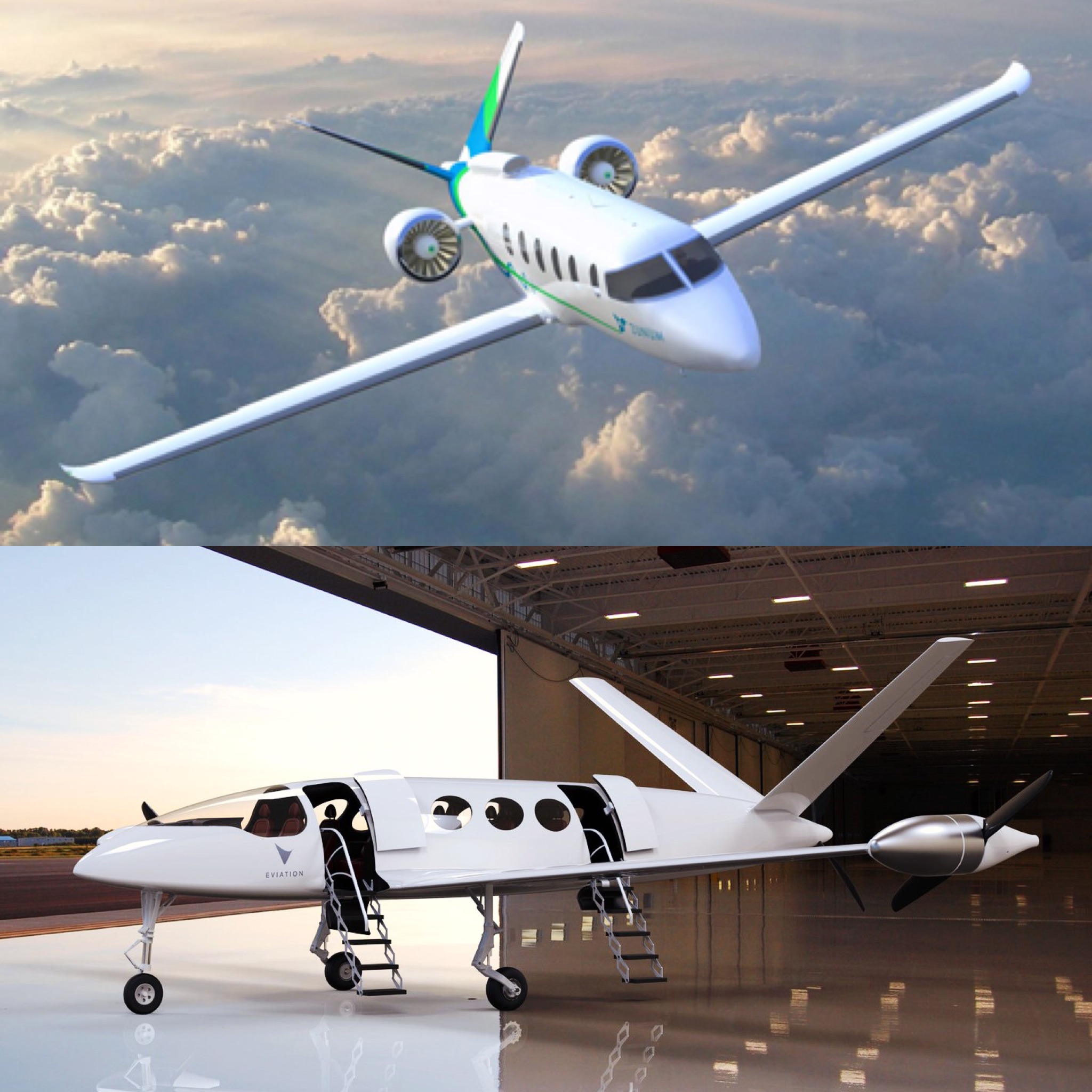
Zunum Aero (top), Eviation Aircraft (bottom)
Other Exciting Developments Coming Soon:
In the heavyweight division Airbus, Siemens, and Rolls-Royce have their own partnership, working together on their E-Fan X after the successful small electric E-Fan program. The E-Fan X will be a hybrid demonstrator aircraft based on the 100-seat BAe146. The first test flight is planned for 2020 and they are looking to bring a similarly sized hybrid aircraft to market sometime around 2030. Originally they were going to bring a small electric trainer based on the E-Fan to market in 2017 or 2018 but said the pace of development has set their ambitions upwards. There’s also Airbus’s subsidiary A3 which is working on a small all-electric vertical takeoff and landing aircraft.
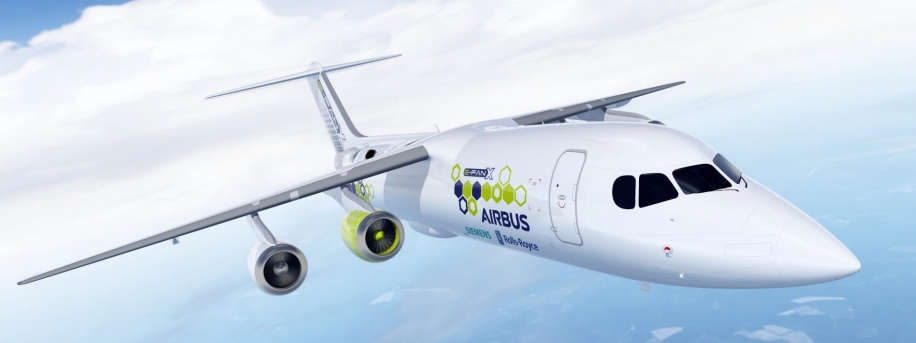
E-Fan X
Vertical takeoff and landing aircraft are extremely interesting. They could be the biggest disrupters of all (covered in more detail in a follow up article, part 2). They too seem to be much closer than people think. For flying short distances they don’t actually need massive advancements in battery technology. Norway’s Avinor, their national aircraft operator, seems to indicate the mid 2020’s for practical operation.
Companies like Uber, Lilium, Kittyhawk, A3, and many more are developing electric aircraft capable of vertical takeoff and landing. They look more like flying cars than airplanes and that seems to be the point. These “air-taxis” are meant for hyper-local travel. Something you would hop onto downtown and take to get to across the city or to another nearby city. Lilium is a relatively new startup, founded in 2015, but has already made significant advancements in the space. They’ve already had their first full-scale test flight which is viewable below. Watching it lift off is almost magical. They brought on former Ferrari designer Frank Stephenson to head their design program and raised $90M to proceed with further development.
Lilium VTOL
Final Thoughts and Intro to Part 2
For fully electric flight a lot depends on batteries, but the technology is already finding applications in short-range, small aircraft. Increasing larger hybrid aircraft are also set to see their application in the real world in just a few years and will yield substantial benefits of their own. These moves should not be discounted. They are a prelude of what’s to come.
At this point, you may be wondering exactly what are the benefits of electric flight. That’s the focus of the second part of this article, coming out soon. They are substantial and will drive the industry forward with haste.
Elon Musk
Tesla Supercharger Diner food menu gets a sneak peek as construction closes out
What are you ordering at the Tesla Diner?

The Tesla Supercharger Diner in Los Angeles is nearing completion as construction appears to be winding down significantly. However, the more minor details, such as what the company will serve at its 50s-style diner for food, are starting to be revealed.
Tesla’s Supercharger Diner is set to open soon, seven years after CEO Elon Musk first drafted the idea in a post on X in 2018. Musk has largely come through on most of what he envisioned for the project: the diner, the massive movie screens, and the intended vibe are all present, thanks to the aerial and ground footage shared on social media.
We already know the Diner will be open 24/7, based on decals placed on the front door of the restaurant that were shared earlier this week. We assume that Tesla Optimus will come into play for these long and uninterrupted hours.
The Tesla Diner is basically finished—here’s what it looks like
As far as the food, Tesla does have an email also printed on the front door of the Diner, but we did not receive any response back (yet) about what cuisine it will be offering. We figured it would be nothing fancy and it would be typical diner staples: burgers, fries, wings, milkshakes, etc.
According to pictures taken by @Tesla_lighting_, which were shared by Not a Tesla App, the food will be just that: quick and affordable meals that diners do well. It’s nothing crazy, just typical staples you’d find at any diner, just with a Tesla twist:
Tesla Diner food:
• Burgers
• Fries
• Chicken Wings
• Hot Dogs
• Hand-spun milkshakes
• And more https://t.co/kzFf20YZQq pic.twitter.com/aRv02TzouY— Sawyer Merritt (@SawyerMerritt) July 17, 2025
As the food menu is finalized, we will be sure to share any details Tesla provides, including a full list of what will be served and its prices.
Additionally, the entire property appears to be nearing its final construction stages, and it seems it may even be nearing completion. The movie screens are already up and showing videos of things like SpaceX launches.
There are many cars already using the Superchargers at the restaurant, and employees inside the facility look to be putting the finishing touches on the interior.
🚨 Boots on the ground at the Tesla Diner:
— TESLARATI (@Teslarati) July 17, 2025
It’s almost reminiscent of a Tesla version of a Buc-ee’s, a southern staple convenience store that offers much more than a traditional gas station. Of course, Tesla’s version is futuristic and more catered to the company’s image, but the idea is the same.
It’s a one-stop shop for anything you’d need to recharge as a Tesla owner. Los Angeles building permits have not yet revealed the date for the restaurant’s initial operation, but Tesla may have its eye on a target date that will likely be announced during next week’s Earnings Call.
News
Tesla’s longer Model Y did not scale back requests for this vehicle type from fans
Tesla fans are happy with the new Model Y, but they’re still vocal about the need for something else.

Tesla launched a slightly longer version of the Model Y all-electric crossover in China, and with it being extremely likely that the vehicle will make its way to other markets, including the United States, fans are still looking for something more.
The new Model Y L in China boasts a slightly larger wheelbase than its original version, giving slightly more interior room with a sixth seat, thanks to a third row.
Tesla exec hints at useful and potentially killer Model Y L feature
Tesla has said throughout the past year that it would focus on developing its affordable, compact models, which were set to begin production in the first half of the year. The company has not indicated whether it met that timeline or not, but many are hoping to see unveilings of those designs potentially during the Q3 earnings call.
However, the modifications to the Model Y, which have not yet been officially announced for any markets outside of China, still don’t seem to be what owners and fans are looking forward to. Instead, they are hoping for something larger.
A few months ago, I reported on the overall consensus within the Tesla community that the company needs a full-size SUV, minivan, or even a cargo van that would be ideal for camping or business use.
Tesla is missing one type of vehicle in its lineup and fans want it fast
That mentality still seems very present amongst fans and owners, who state that a full-size SUV with enough seating for a larger family, more capability in terms of cargo space for camping or business operation, and something to compete with gas cars like the Chevrolet Tahoe, Ford Expedition, or electric ones like the Volkswagen ID.BUZZ.
We asked the question on X, and Tesla fans were nearly unanimously in support of a larger SUV or minivan-type vehicle for the company’s lineup:
🚨 More and more people are *still* saying that, despite this new, longer Model Y, Tesla still needs a true three-row SUV
Do you agree? https://t.co/QmbRDcCE08 pic.twitter.com/p6m5zB4sDZ
— TESLARATI (@Teslarati) July 16, 2025
Here’s what some of the respondents said:
100% agree, we need a larger vehicle.
Our model Y is quickly getting too small for our family of 5 as the kids grow. A slightly longer Y with an extra seat is nice but it’s not enough if you’re looking to take it on road trips/vacations/ kids sports gear etc.
Unfortunately we…
— Anthony Hunter (@_LiarsDice_) July 17, 2025
Had to buy a Kia Carnival Hybrid because Tesla doesn’t have a true 3 row vehicle with proper space and respectable range. pic.twitter.com/pzwFyHU8Gi
— Neil, like the astronaut (@Neileeyo) July 17, 2025
Agreed! I’m not sure who created this but I liked it enough to save it. pic.twitter.com/Sof5nMehjS
— 🦉Wise Words of Wisdom – Inspirational Quotes (IQ) (@WiseWordsIQ) July 16, 2025
Tesla is certainly aware that many of its owners would like the company to develop something larger that competes with the large SUVs on the market.
However, it has not stated that anything like that is in the current plans for future vehicles, as it has made a concerted effort to develop Robotaxi alongside the affordable, compact models that it claims are in development.
It has already unveiled the Robovan, a people-mover that can seat up to 20 passengers in a lounge-like interior.
The Robovan will be completely driverless, so it’s unlikely we will see it before the release of a fully autonomous Full Self-Driving suite from Tesla.
Energy
Tesla launches first Virtual Power Plant in UK – get paid to use solar
Tesla has launched its first-ever Virtual Power Plant program in the United Kingdom.

Tesla has launched its first-ever Virtual Power Plant program in the United Kingdom. This feature enables users of solar panels and energy storage systems to sell their excess energy back to the grid.
Tesla is utilizing Octopus Energy, a British renewable energy company that operates in multiple markets, including the UK, France, Germany, Italy, Spain, Australia, Japan, New Zealand, and the United States, as the provider for the VPP launch in the region.
The company states that those who enroll in the program can earn up to £300 per month.
Tesla has operated several VPP programs worldwide, most notably in California, Texas, Connecticut, and the U.S. territory of Puerto Rico. This is not the first time Tesla has operated a VPP outside the United States, as there are programs in Australia, Japan, and New Zealand.
This is its first in the UK:
Our first VPP in the UK
You can get paid to share your energy – store excess energy in your Powerwall & sell it back to the grid
You’re making £££ and the community is powered by clean energy
Win-win pic.twitter.com/evhMtJpgy1
— Tesla UK (@tesla_uk) July 17, 2025
Tesla is not the only company that is working with Octopus Energy in the UK for the VPP, as it joins SolarEdge, GivEnergy, and Enphase as other companies that utilize the Octopus platform for their project operations.
It has been six years since Tesla launched its first VPP, as it started its first in Australia back in 2019. In 2024, Tesla paid out over $10 million to those participating in the program.
Participating in the VPP program that Tesla offers not only provides enrolled individuals with the opportunity to earn money, but it also contributes to grid stabilization by supporting local energy grids.
-

 Elon Musk1 day ago
Elon Musk1 day agoWaymo responds to Tesla’s Robotaxi expansion in Austin with bold statement
-

 News1 day ago
News1 day agoTesla exec hints at useful and potentially killer Model Y L feature
-

 Elon Musk2 days ago
Elon Musk2 days agoElon Musk reveals SpaceX’s target for Starship’s 10th launch
-

 Elon Musk3 days ago
Elon Musk3 days agoTesla ups Robotaxi fare price to another comical figure with service area expansion
-

 News1 day ago
News1 day agoTesla’s longer Model Y did not scale back requests for this vehicle type from fans
-

 News1 day ago
News1 day ago“Worthy of respect:” Six-seat Model Y L acknowledged by Tesla China’s biggest rivals
-

 News2 days ago
News2 days agoFirst glimpse of Tesla Model Y with six seats and extended wheelbase
-

 Elon Musk2 days ago
Elon Musk2 days agoElon Musk confirms Tesla is already rolling out a new feature for in-car Grok








